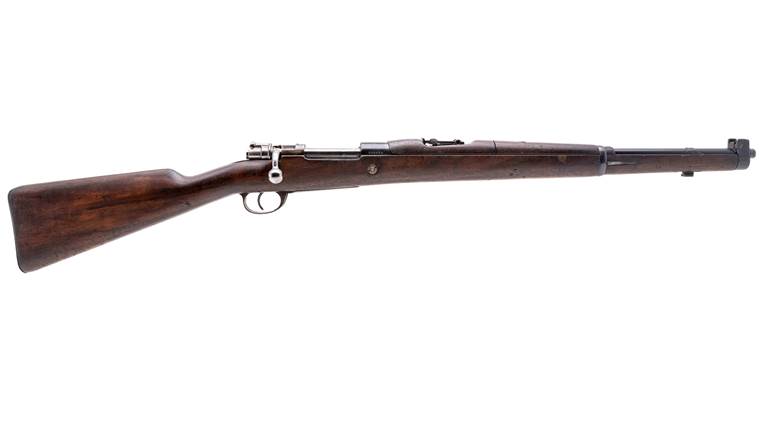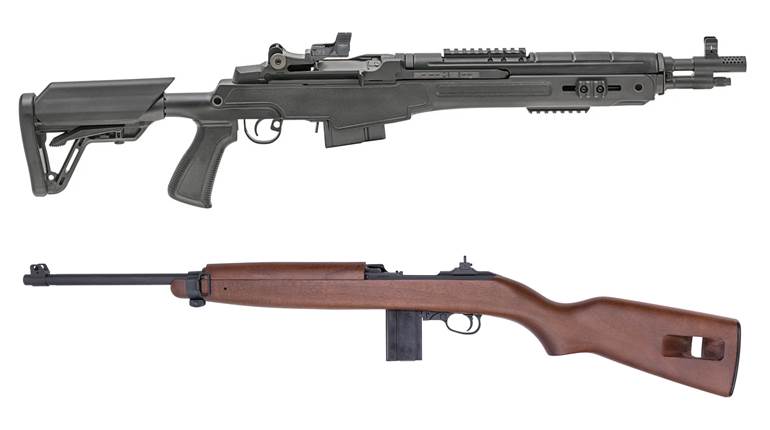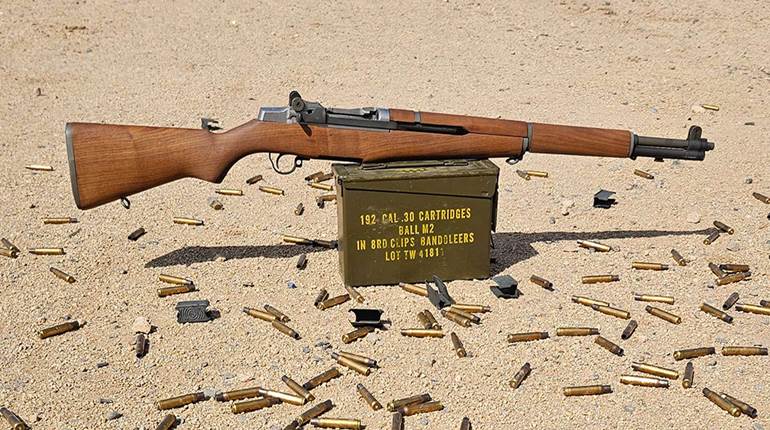
The Republic of Argentina has a large and diversified military-industrial complex, which includes a remarkable history of gun-making. During the 19th century, they imported designs like the Remington Rolling Block rifle and the Model 1891 Mauser in 7.65x53 mm armed “las Fuerzas Armadas” (“the armed forces”). During the first half of the 20th century, Argentina used arms such as the American M1911A1 .45-ACP self-loading pistol and the Model 1909 Mauser rifle also in 7.65 mm. At first the Argentine government bought pistols and rifles directly from the United States and Germany, but that paved the way for licensed domestic production by the Dirección General de Fabricaciones Militares (the General Directorate of Military Manufacturing or “DGFM”).
To support this, the DGFM established various plants to build small arms and small arms ammunition. Among them was the Fábrica Militar de Armas Portátiles (Military Small Arms Factory or “FMAP”) in Rosario. Named in honor of the notable 19th Century Argentine military leader and politician Domingo Matheu, the FMAP in Rosario ultimately manufactured the Fusil Mauser Argentino Modelo 1909 (Model 1909 Argentine Mauser), the Sistema Colt Cal. 11.25 mm Modelo 1927 pistol and other noteworthy military and commercial firearms.

The two American rifles (pictured left) duplicated in 1953 by Argentina’s DGFM. The duplicate prototype of the Model 1941 Johnson rifle was built in Cordoba by Industrias Aeronáuticas y Mecánicas del Estado (National Aeronautical and Mechanical Industries or “I.A.M.E.”). The duplicate prototype M1 Garand rifle was built in Rosario at the state-owned FMAP “Domingo Matheu” factory. Pictured right is the “M-uno” (as they call it). It was produced in 1953 at Argentina’s state-owned FMAP “Domingo Matheu” factory in Rosario, Santa Fe. An exact copy of the American M1 Garand, FMAP’s Fusil Semiautomatico Cal. 7.65 has a polished blued finish and a bare metal operating rod and bolt.
At the beginning of Juan Domingo Perón’s second term as president in 1951, the Argentine military began the process of finding a replacement for the obsolete bolt-action Mauser rifles that had armed its forces for half a century. With practically every other army in the world now using self-loading battle rifles of various designs, the time had finally come for “las Fuerzas Armadas Argentino” to adopt something more modern.
The DGFM therefore commenced a study to determine what automatic rifle would replace its existing inventory. The two highly esteemed arms first chosen as candidates to become Argentina’s next service rifle were the German StG44 Sturmgewehr and the legendary American M1 Garand. On January 10, 1953, the FMAP Domingo Matheu plant was instructed to produce a duplicate prototype of the U.S. M1 Garand in 7.65x53 mm and the StG44 Sturmgewehr in its original 7.92x33 mm (7.92 Kurz). Simultaneously, an order was placed with Fábrica Argentina Militar de Munición de Armas Portátiles (National Military Small Arms Ammunition Factory or “FAMMAP”) in San Lorenzo to manufacture a lot of 1,000 7.92x33 mm cartridges for testing the Sturmgewehr prototype upon completion. Work on the two designs commenced in February 1953 with initial activity dedicated to development of the tooling that would be necessary for production.
As the prototypes began to take shape at FMAP Domingo Matheu during the summer of 1953, a third rifle was selected to be considered alongside the Sturmgewehr and Garand—the Model of 1941 Johnson rifle. Since the Domingo Matheu factory was working to build the other weapons, Industrias Aeronáuticas y Mecánicas del Estado (National Aeronautical and Mechanical Industries or “IAME”) in Cordoba was instructed to duplicate the Johnson. Like FMAP’s Garand, IAME’s Johnson prototype was chambered for the 7.65x53 mm cartridge.
The three rifles produced in 1953 by Argentina's DGFM. At the time, Argentina was interested in upgrading from its obsolete Mauser Model 1891 and Model 1909 bolt-action rifles to some type of modern, self-loading rifle. As that was the case, DGFM authorized two state-owned factories to produce duplicate prototypes of the Model of 1941 Johnson rifle, the M1 Garand rifle and the German StG44 carbine for production evaluation.
All three were faithfully reproduced, although none were given serial numbers. The Sturmgewehr was finished with a dull grey phosphate while the Johnson and the Garand were both given a deep, polished blue finish. Interestingly, the Garand’s operating rod, operating rod catch, magazine follower, follower arm, bolt, hammer, safety and trigger were left unfinished bare metal. Rather than being built with the product improved T105E1 type rear sights (which were being installed on production rifles at Springfield, International Harvester and Harrington & Richardson at that time), Type 2 Lock Bar rear sights were duplicated for the FMAP Garand. No graduation numbers or markings of any kind were placed on the windage or elevation knobs although they were knurled in a manner resembling Type 2 and 3 knobs.
Obviously, FMAP Domingo Matheu used a World War II production gas port M1 rifle as the pattern when it produced its duplicate. When all three were completed, the next phase of testing was ready to begin. On Jan. 14, 1954, the Argentine Ministry of Defense established the Instituto de Investigaciones Científicas y Técnicas de las Fuerzas Armadas (Armed Forces Scientific and Technical Research Institute or “IICTFA”) with a general directive to conduct testing and evaluation trials of weapons. The completed IAME Johnson rifle and DGFM’s StG44 and M1 Garand were shipped to the IICTFA in August and the process of evaluating them commenced. But even as these tests began to move forward, the winds of change were beginning to blow in a different direction.

The markings on the receiver heel of the Argentine M1 Garand (pictured left) read: Fusil Semiautomatico Cal. 7.65, DGFM, FMAP Año 1953 or “Semi-automatic 7.65 caliber rifle, General Directorate for Military Manufacturing (DGFM), Military Small Arms Factory (FMAP), in the year 1953.” The receiver markings on the Argentine duplicate prototype of the Model 1941 Johnson rifle (pictured right) read: “I.A.M.E. Fusil Semiautomatico, Calibre 7.65.” This stands for Industrias Aeronáuticas y Mecánicas del Estado (or National Aeronautical and Mechanical Industries) Semi-automatic Rifle, Caliber 7.65.
In a letter dated May 30, 1955, Gen. Nestor Arana—the director of the IICTFA—questioned the wisdom of continuing to evaluate the IAME and FMAP weapons. By then a promising new automatic rifle was attracting the attention of the Argentine Ministry of Defense: Fabrique Nationale’s Fusil Automatique Léger or FAL. In September 1955, the IICTFA’s assessment of the Johnson, the StG44 and the Garand was placed on hold so that the FN FAL could be evaluated. In the end, Argentina adopted Fabrique Nationale’s now famous automatic rifle—at first with the direct purchase of FALs produced at the FN factory in Herstal near Liège, Belgium. In 1960 the DGFM began domestic production of the FAL at FMAP Domingo Matheu and the duplicate prototypes of the Johnson, the StG44 and the Garand went into long-term storage at the IICTFA.

The Argentine StG44 duplicate prototype was produced in 1953 at the state-owned FMAP “Domingo Matheu” factory in Rosario, Santa Fe. An exact copy of the German Sturmgewehr, FMAP’s prototype carries no markings aside from the fire-control selector switch and range numbering on the adjustable rear sight.
These three unique and interesting guns remained in complete obscurity locked away in a vault until April 1996. At that time, the IICTFA—renamed Centro de Investigaciones Científicas y Técnicas de las Fuerzas Armadas (Armed Forces Center for Scientific and Technological Research or “CITEFA”)—donated them to Museo de Armas de la Naciôn (National Arms Museum) at Circulo Militar in Buenos Aires. The three prototypes are on display there now in the museum’s “Paseo de la Libertad” (“Walk of Freedom”) gallery. In addition to one of the most remarkable firearms collections in the Americas, Museo de Armas de la Naciôn also houses the three oddities that at one time were being considered as Argentina’s next service rifle. It took the incomparable FN FAL to eclipse them.

Pictured left is the crest of the Museo de Armas de la Naciôn (National Arms Museum) in Buenos Aires. Pictured right is a display case in the "Jorge Newbery" gallery of the museum showing the various types of military and sporting arms produced by Argentina's DGFM. Everything from muskets to automatic rifles, sub-machine guns, pistols, rifle grenades and land mines have been produced by the DGFM.





































